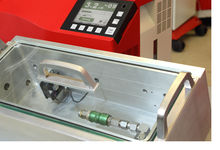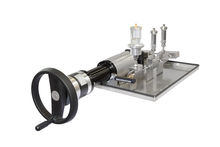11. February 2016
Maximator expands range of testing services in the MAXIFES test laboratory
Category News
This company, which is one of the leading suppliers of systems and components for high-pressure equipment, has operated the MAXIFES test laboratory at its head office for more than 15 years. This 500 square meter facility is used to carry out pressure, bursting, pulsation pressure and durability tests on parts and assemblies and also auto-frettage systems.
Very recently a helium-leak test system for highly precise leak tests and a spindle press unit that can generate pressure levels of more than 10,000 bar to calibrate pressure measuring units have been intalled. Furthermore also a pulsation and bursting pressure test system for large-volume parts up to a length of 4 meters and a volume of 400 litres will be installed. In addition, the laboratory has a temperature chamber to allow testing at temperatures of between -40 °C to + 200 °C.
New: Helium-leak test system and spindle press calibration unit
 The new leak test system is designed to test for leaks in test parts of various sizes. The chemically inert gas helium is used as a test medium because its atoms are so small that they can pass through even the most smallest location – for instance in welded joints or screw connections. The leaks on large parts are detected using a helium probe that ‘sniffs’ out the escaping gas. Vacuum tests are used on smaller parts or parts that operate with under-pressure. In this case, a vacuum is created inside the test part that is then measured to see how quickly the inner pressure increases, if helium flows into through the leaks from the outside. This procedure is very inexpensive because the small size of the helium atoms means that only relatively low pressure levels are required in the test.
The new leak test system is designed to test for leaks in test parts of various sizes. The chemically inert gas helium is used as a test medium because its atoms are so small that they can pass through even the most smallest location – for instance in welded joints or screw connections. The leaks on large parts are detected using a helium probe that ‘sniffs’ out the escaping gas. Vacuum tests are used on smaller parts or parts that operate with under-pressure. In this case, a vacuum is created inside the test part that is then measured to see how quickly the inner pressure increases, if helium flows into through the leaks from the outside. This procedure is very inexpensive because the small size of the helium atoms means that only relatively low pressure levels are required in the test.
 Pressure transducers and other pressure measuring instruments designed for pressure levels in excess of 10,000 bar can be calibrated with the spindle press system. Periodic calibration is necessary to ensure that the instruments display correct values. One of the biggest advantages of the new calibration system, which has been developed in-house, is that it can be set very precisely using a spindle with a fine thread.
Pressure transducers and other pressure measuring instruments designed for pressure levels in excess of 10,000 bar can be calibrated with the spindle press system. Periodic calibration is necessary to ensure that the instruments display correct values. One of the biggest advantages of the new calibration system, which has been developed in-house, is that it can be set very precisely using a spindle with a fine thread.
Coming soon: New test system for large-volume parts
Another system that will be ready for use soon is a pulsation and bursting pressure test system for large-volume parts, for instance tanks in lengths of up to four metres. The special features of this system include the option to apply additionally defined bending and torsion torques to the test item during the test. Shock loads or overlayering of small cycles within the pulsation pressure amplitudes can be minimised thanks to the use of a pressure intensifier. The expansion propertiesof the test item can be recorded during the test with an accuracy of up to 0.1 mm using laser-optical units that allow direct statements to be made about the expansion volume.
There is a bursting chamber in the test system included; the test can be observed through windows made of safety glass and recorded with cameras. And, for the first time, the bursting process can been captured using a high-speed film. These kinds of insights into the bursting behaviour of a test item open up new possibilities for assessing parts and also save time in the development process. The system can also be used to test pressurized tanks, e.g. gas tanks for natural gas and hydrogen-operated vehicles.
Testing at a defined temperature
The MAXIFES test centre also has a temperature chamber that can be used for conducting tests at certain temperatures. Pressure, volume and temperature are physically related. Some pressurized components are designed to work under specific temperature conditions and therefore need to be tested in defined ambient conditions. Also, temperature fluctuations in pressure tests on certain components can impact on the measuring results making them less reliable. For this reason test parts are examined in the temperature chamber at a defined temperature, which can be set between -40 °C and + 200 °C.
More than just pressure tests
Typically, low-pressure and high-pressure tubing, high-pressure parts and screw connections, hydraulic parts, hoses, fittings, tanks and other hollow vessels, pressure transducers and also parts used in diesel and petrol injections systems, e.g. common rail systems, are tested in the MAXIFES test laboratory based on customer specifications.
Clients that commission external testing services profit from the fact that the high-pressure specialist not only carries out tests but can also, on request, issue recommendations and draft detailed test reports that are recognised by e.g. leading automobile companies. The staff at the testing laboratory test prototypes, new products and also product series; they help companies to conduct their own tests, if they have limited testing capacities and also help clients to optimise the design of pressurized parts.
Maximator is therefore an essential partner in the research & development field and plays an important role in cutting costs in the cost-intensive research field. A further advantage is that Maximator can also use its own valves or fittings, or quickly produce parts in-house, as highly-tight screw connections in the tests.
Maximator conducts pressure tests for customers all across the world. In addition to the MAXIFES test laboratory in Germany, Maximator also operate the Maximator Test LLC laboratory in the USA, and a further laboratory is currently under construction in Shanghai.
Maximator expands range of testing services.pdf
Language: EnglishThe latest five articles
01. October 2025
Save the Date: Hydrogen Technology Expo Europe 2025 and SK Get Together
Maximator will be presenting its hydrogen portfolio at Hydrogen Technology Expo Europe 2025 and has a very special highlight - the SK Get Together! You are cordially invited to discuss the latest innovations in the world of hydrogen over a few cold drinks!
31. March 2025
Pioneering breakthrough in high-pressure valve technology
Maximator GmbH's new ValvolutionX valve series offers nominal sizes up to 1 inch with a 50% more compact and 75% lighter design
24. March 2025
New Chapter, New Opportunities - Foundation Maximator Poland
Maximator starts a new chapter with the foundation of Maximator Poland.
07. February 2025
ValvolutionX live at Hannover Messe 2025
Discover the latest generation of valve technology for hydrogen from Maximator live at HANNOVER MESSE 2025.
11. December 2024
The challenge: Small actuator for large nominal diameters
We came up with something clever and rethought the shut-off valve!